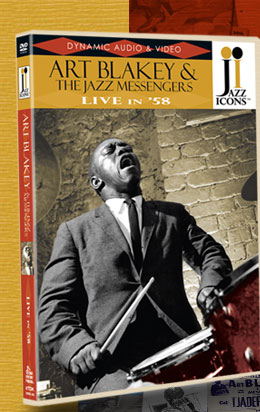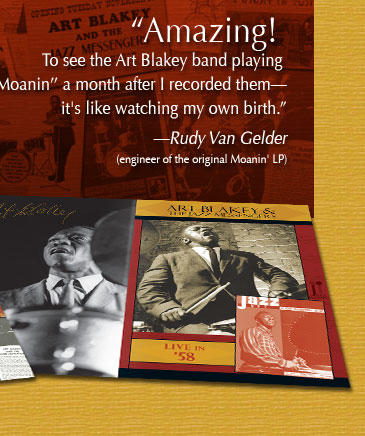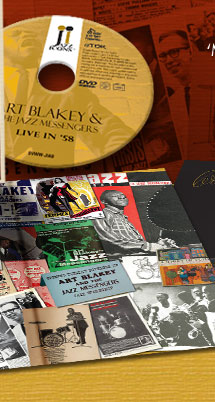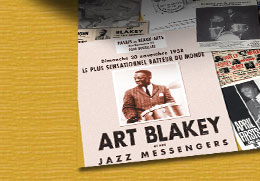
Foreword: Art Blakey is a national and international treasure. He dedicated his life to jazz music and helped the careers of countless jazz musicians with his band the Jazz Messengers. In the music industry, Art Blakey is a legend; but to his family, he was just “Pop."
Pop was small in stature, but he was a giant when it came to having a generous heart. Whether he was taking the neighborhood kids on a camping trip or helping a friend in need from all walks of life, he taught his children and grandchildren about compassion and the joy of giving. Art Blakey’s recordings, insight, and passion for his craft were his gift to the myriad of people around the world who were moved and inspired by his music. As he used to say, “To pass through life and miss this music is to miss out on one of the best things about living.” It is our gift and greatest honor as his children and grandchildren to keep his memory alive and to ensure that future generations do not miss out on his music.
—Takashi Blakey
(Son of Art Blakey)
May 2006
Sample Liner Notes by Michael Cuscuna: Art Blakey was born in Pittsburgh on October 11, 1919, less than one year after the end of World War I and just three months before Prohibition went into effect, giving alcohol consumption and organized crime a tremendous boost and setting the scene for the Jazz Age. Like most boys born to large, impoverished families in Pittsburgh, who came of age during the Depression, Blakey put in his time in the coal mines during his teenage years. He studied piano in school and, by age 14, he was getting gigs with his own band. He had found his ticket out.
A couple of years later, the owner of the Democratic Club insisted that Blakey give up his piano chair to a young Erroll Garner. Blakey was forever after a drummer; and he was in fact one of the most magnificent drummers jazz has produced.
Under the tutelage of the great Chick Webb, whom Art spoke of with great reverence throughout his life, Blakey went professional, leaving Pittsburgh to join Fletcher Henderson in 1939. Blakey’s big break came in 1944 when he joined Billy Eckstine’s band, which was filled with such bebop pioneers as Dizzy Gillespie, Dexter Gordon, Gene Ammons and Leo Parker. In this open, creative context, Blakey’s style blossomed, and his power and drive grew. When asked how he achieved such a big sound on the tenor saxophone, Ammons liked to answer, “I had no choice; I was sitting in front of Art Blakey in the Eckstine band.”
Blakey’s style proved groundbreaking in the context of small group jazz. He didn’t just support and react to the music and the soloist; he helped shape the performance. Blakey memorized every nuance of an arrangement and built the dynamics carefully to a climax behind each soloist, in effect, helping to shape the solo itself. His vocabulary of original devices included rising press rolls, a clipped incessant hi-hat, a loose shuffle beat, his variation of a Latin beat using the bell of the cymbal, mallet work, a flutter effect on the rim of the snare drum and splash cymbals that sound more like gongs.
....
The band was loaded for bear on this night at the Palais Des Beaux Arts in Brussels . Everyone’s looking sharp and playing at a high level, particularly 20-year-old Lee Morgan. Art Blakey looks happy and rested sitting behind the hippest drum set of the day: a Gretsch sparkle set with the smaller size drums (8" x 12" mounted tom tom, 14" x 14" floor tom and 18" bass drum) for a tighter, more modern sound.
The fact that there were only two, possibly three, cameras used for the filming of this concert is a blessing. We get plenty of solid shots of the full band interacting and the appropriate revealing close-ups of the soloists’ faces. The cameras seem to be shooting where our attention would be drawn if we were actually there.
Benny Golson’s “Just By Myself” opens the concert. Lee Morgan debuted this composition on his August 1957 City Lights album, and Dizzy Gillespie recorded a marvelous octet version four months later—both versions with wonderful arrangements by the composer. The Jazz Messengers recorded it at the Olympia Theatre in Paris just eight days before this performance. Golson described the piece to Leonard Feather in the original notes of the Morgan album as “a 36-bar chorus, each half chorus containing 18 bars. This should really be a 32-bar composition, but actually two extra bars come at the beginning of each 16. It is the direct opposite of a tag and might very well be called a 32-bar composition with two two-bar ‘reverse tags.’ The first eight bars in this tune gave me a feeling of complete loneliness and desolation; consequently I arrived at the title ‘Just By Myself.’”
On this version, which starts right on the melody, Lee Morgan is the first soloist, and his long fluid lines and stream of ideas are a thing to behold. He gives the perfect weight to each note and his pitch and tone are clean and spot on. To actually see him playing this way at the age of 20 really drives home what a remarkable musician he was. Benny Golson’s solo is uncharacteristically forceful, especially on the tags, but rich in melodic content. Bobby Timmons begins his solo toying with licks from the tenor solo and is more boppish in phraseology and approach than most of his work.
Back to top of page
All words and artwork on this page ©Reelin' In The Years Productions. Unauthorized use is prohibited. | 












